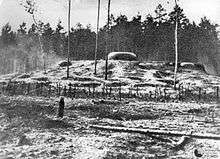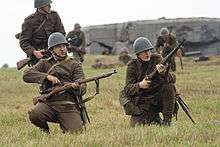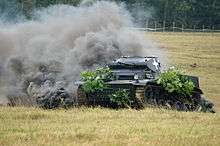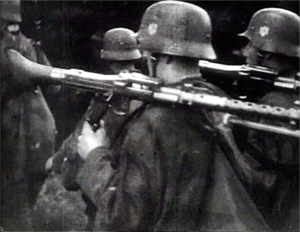Battle of Mława
| ||||||||||||||||||||||||||||||
The Battle of Mława, otherwise known as the Defence of the Mława position, took place to the north of the town of Mława in northern Poland between September 1 and September 3, 1939. It was one of the opening battles of the Invasion of Poland and World War II in general. It was fought between the forces of the Polish Modlin Army under General Krukowicz-Przedrzymirski and the German 3rd Army under General Georg von Küchler.[1]:43
History
Eve of the Battle
As a result of the Treaty of Versailles, the new German-Polish border was located only some 120 km north of Warsaw, the Polish capital city. In 1939 the Polish Modlin Army, led by Brigadier General Emil Krukowicz-Przedrzymirski, was thought of as the main defensive force guarding Polish borders from the north. It was located along the border with East Prussia and was to stop the enemy forces advancing towards Warsaw, the Modlin Fortress. Shortly before the war, a decision was made to strengthen the Polish defences by construction of a line of field fortifications and concrete bunkers to the north of Mława, in the centre of the army's positions.
The main line of defence of the army was located along the line of Narew and Vistula rivers. There were a number of 19th-century fortifications in the area, but the plains to the north of it were almost defenseless. To ease the delaying actions in case of a war with Germany, the Polish General Staff decided that the Modlin Army should be transported to the border with East Prussia and should defend the line for as long as possible. Afterwards, the units under command of General Przedrzymirski-Krukowicz were to withdraw to the south and defend the line of Narew and Vistula rivers, together with the forces of Narew Independent Operational Group.
After the Polish secret mobilization had started in March 1939, the 20th Infantry Division was assigned to the Modlin Army and transported to the area of Mława. In addition, the army commander was assigned a number of trainloads of concrete and other construction materials and several combat engineering battalions. It was decided that a line of fortifications should be constructed in the area held by that division. On June 19 of that year, the project was ready and was finally approved by Marshal of Poland Edward Rydz-Śmigły on July 3.
The line of trenches and concrete bunkers, shielded by anti-tank trenches and obstacles, was to be constructed along a low glacial hill overlooking the valley of the Mławka river, to the north of the town. The river itself could be blocked by a dam to enhance the defensive capability of the area. In the center, the swampy terrain of the Niemyje Marshes was located, which was virtually impassable to enemy armored vehicles. This swamp divided the area into two separate flanks. The western section was to be reinforced with 68 concrete bunkers while the eastern, much shorter, with 25.
In peacetime the 20th Division was located in Baranowicze. In case of a war with the USSR, it was planned as the first-line unit to defend a line of German World War I fortifications built there in 1915. Because of that, most of its soldiers had experience in defending fortified positions.



The construction of bunkers in the western section of the front, near the town of Mława, was started on July 14. It was carried out mostly by the soldiers themselves, under the command of the head of the 20th engineering battalion, Maj. Juliusz Levittoux. The construction of the eastern flank bunkers near the village of Rzęgnowo started on August 12. Soon the soldiers were joined by a number of civilian volunteers, helping to dig the trenches. However, the positions were not finished until the outbreak of World War II and many of the bunkers were not completed.
Battle
At noon on September 1, 1939 the Polish line of defence manned by the 20th Infantry Division was attacked by the 1st Army Corps under General Walter Petzel. Although the attacking forces were equipped with tanks and supported by warplanes, the initial assault was repelled by Polish-made 37mm Armata ppanc. wz. 36 anti-tank guns. Georg von Küchler, the commander of German Third Army, ordered his units to attack the Polish forces several times in a row, but all attacks were broken and in the late evening the Germans were forced to withdraw to their initial positions.
The following afternoon the German units started heavy artillery bombardment of the Rzegnów position on the right flank of the Polish forces. After two hours of constant artillery fire, the assault was started and, in the result of close combat, the Polish defenders started to waver. The counterattack of the Polish 79th Infantry Regiment was unsuccessful and the commander of the Polish Modlin Army ordered the 20th Division to extend further eastwards and prepare the defence of its right flank between the villages of Dębsk and Nosarzewo. At the same time the 8th Infantry Division, until then held in reserve near Ciechanów, was ordered to prepare a counterattack.
The 8th Division arrived in the area in the early hours of September 3. As the Mazovian Cavalry Brigade operating further eastwards was also endangered by German armoured troops, the army commander ordered the division to split its forces and attack in two directions: towards Grudusk east of Mława and towards Przasnysz. However, conflicting orders and German diversants operating in the rear disrupted both attacks and led to chaos in the Polish ranks. In the evening the division was mostly destroyed and only the 21st Infantry Regiment of Colonel (later General) Stanisław Sosabowski managed to withdraw from the fights towards the Modlin Fortress. Despite this, the German attacks towards both flanks of the 20th Infantry Division were unsuccessful.
On September 3 the German engineers finally managed to cut through Polish antitank barriers. The Germans used the local civilians as human shields,[2][3][4] which allowed them to finally capture several bunkers on the left flank of the Polish forces, but were unable to push forwards. On the right flank, in the Rzegnów section of the front to the east of the swamps, the attacks were more successful and in the late evening elements of German Wodrig Corps finally broke through the lines of the 79th Infantry Regiment to the rear of the Poles. This widened the front gap in the area of Grudusk.
General Emil Krukowicz-Przedrzymirski, facing the risk of his forces being outflanked and surrounded, ordered the 20th division and the remnants of the 8th to withdraw towards Warsaw and Modlin, finally abandoning the fortified positions.
Aftermath
The withdrawal was started in the early morning of September 4. Although the German mechanized units suffered heavy losses and were unable to maintain pursuit, the area to the south of Mława was very lightly forested and the Polish forces were constantly bombarded and strafed by the German Luftwaffe, suffering heavy losses both in troops and equipment.
Although the position was abandoned, the German forces suffered substantial losses and it was not until September 13, when they finally managed to reach the Modlin Fortress, located less than 100 kilometres to the south.
Opposing forces
Poland
| Polish Army | Army | Division | Unit | Remarks | |||||||||
|---|---|---|---|---|---|---|---|---|---|---|---|---|---|
| Edward Rydz-Śmigły HQ in Warsaw |
Modlin Army Krukowicz-Przedrzymirski |
20th Infantry Division Liszka-Lawicz |
78th Słuck Infantry Regiment Dudziński |
NE of Mława | |||||||||
| 79th Lew Sapieha Regiment of Słonim Rifles Zaborowski |
Rzegnowo position | ||||||||||||
| 80th Nowogródek Rifles Infantry Regiment Fedorczyk |
N of Mława | ||||||||||||
| 8th Infantry Division Wyrwa-Furgalski |
13th Infantry Regiment |
in reserve | |||||||||||
| 21st Warsaw Infantry Regiment Sosabowski |
in reserve | ||||||||||||
| 32nd Infantry Regiment |
in reserve | ||||||||||||
Germany
| Wehrmacht | Army | Division | Unit | Remarks | |||||||||
|---|---|---|---|---|---|---|---|---|---|---|---|---|---|
| 3rd Army Georg von Küchler |
I Corps Petzel |
Kempf Panzer Division Kempf |
7th Panzer Regiment |
||||||||||
| Motorized Infantry Regiment Großdeutschland |
|||||||||||||
| 11th Infantry Division Bock |
2nd Infantry Regiment |
||||||||||||
| 23rd Infantry Regiment |
|||||||||||||
| 44th Infantry Regiment |
|||||||||||||
| 61st Infantry Division Hänicke |
151st Infantry Regiment |
||||||||||||
| 162nd Infantry Regiment |
|||||||||||||
| 176th Infantry Regiment |
|||||||||||||
| Wodrig Corps Wodrig |
1st Infantry Division von Kortzfleisch |
1st Infantry Regiment |
|||||||||||
| 22nd Infantry Regiment |
|||||||||||||
| 43rd Infantry Regiment |
|||||||||||||
| 12th Infantry Division von der Leyen |
27th Infantry Regiment |
||||||||||||
| 48th Infantry Regiment |
|||||||||||||
| 89th Infantry Regiment |
|||||||||||||
| 3rd Army Reserves Wodrig |
217th Infantry Division Baltzer |
311th Infantry Regiment |
|||||||||||
| 346th Infantry Regiment |
|||||||||||||
| 389th Infantry Regiment |
|||||||||||||
Notes and references
- In-line:
- General:
- Wojciech Zalewski; Andrzej Aksamitowski (1996). Mława 1939 (in Polish). Warsaw: Altair. ISBN 83-86217-31-6.
- "Pozycja Mława". Fortyfikacje polskie II Rzeczypospolitej (1918–1939) (in Polish). Archived from the original on 2005-04-02. Retrieved 2005-05-29.
External links
Coordinates: 53°07′00″N 20°22′00″E / 53.116667°N 20.366667°E
